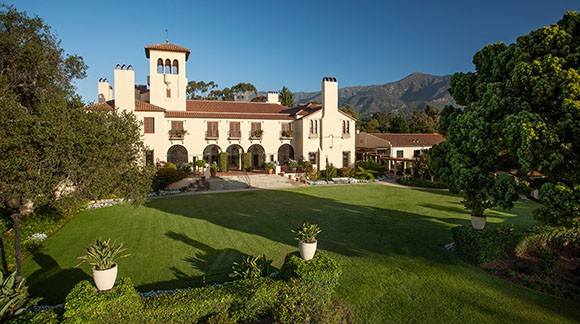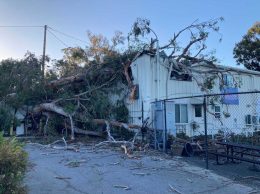Casa Dorinda’s upgrades could cost $30M
IN THIS ARTICLE
- Latest news Topic
- Elijah Brumback Author
By Elijah Brumback Friday, February 20th, 2015

Casa Dorinda, a historic senior living community on 48 acres in Montecito, is in the early stages of an estimated $30 million-plus expansion and renovation. (Courtesy image)
If it had been in the cards for F. Scott Fitzgerald’s ill-fated protagonist Jay Gatsby to become an old man, he might have found the stately accommodations of Casa Dorinda suitable.
And if he somehow managed to come back to life today, the free-spending former bootlegger might find it appealing to know that a substantial expansion is in the works for the Roaring Twenties-era estate.
Casa Dorinda, once known for its high-society scene and extravagant parties, is owned by the nonprofit Montecito Retirement Association and is headed by CEO Ron Shaefer.
The organization has been working to update the property’s master plan over the last decade but recently embarked on a lengthy environmental impact investigation process, documents for which were submitted to the Santa Barbara County Planning and Development Department on Feb. 2.
Spokesperson Kirsten Ayars said work on the final environmental impact report, typically the make-or-break document for almost all development projects in the region, is ongoing.
The major element Casa Dorinda needs to move forward is the approval of a revised major conditional use permit, which would help chart the course of development for the next decade under the organization’s master plan.
With a growing population of seniors, new and expanding long-term care facilities, memory care and senior living communities are part of one of the country’s most active real estate markets. For Casa Dorinda, which already has an long waiting list, the expansion is expected to set up the organization to capitalize on a growing market while providing much-needed housing for area seniors. According to 2010 census data, 26 percent of Montecito residents were 65 and older, and just over 30 percent were in the 45 to 64 age group.
The project
To accommodate some of the expected increase in demand for senior living, Casa Dorinda plans to add roughly 103,000 square feet of space and build 20 independent living units. Renovation of many of the buildings on the property is also part of the plan.
Casa Dorinda’s facilities span 30 buildings that include independent living, personal and memory care units and various support buildings. Existing living space measures about 349,000 square feet, with roughly 46,000 square feet of maintenance and ancillary buildings.
Other major parts of the project include adding six memory care units and six personal care units and two dining facilities. The existing medical clinic would be converted to administrative offices and existing memory care units would be converted to serve as the new clinical space, where it would be closer to residents who are most in need of its services. The auditorium would also be remodeled to provide theater-style seating.
Apart from housing and care facilities, landscaping, parking and traffic flow projects, including a major bridge replacement, are also part of the overall plan.
While Casa Dorinda officials wouldn’t reveal the long-term cost of the project, it’s expected to be upwards of $30 million.
“It’s the only senior retirement campus in the community and this expansion of senior housing is really important,” Ayars told the Business Times. “There has been a lot of interest for this project as it’s been planned over the last couple of years.”
With the expansion, Casa Dorinda expects to hire about 17 additional full-time staff, bringing its total to 234. The existing conditional-use permit limits the total number of residents to 360 and the total number of dwelling units to 286. Casa Dorinda has been operating below that amount.
The proposed project would increase the total number of units by 32 and the number of residents by 36, still keeping the community under its potential build-out capacity. More than 300 residents currently live at Casa Dorinda.
The impact
About 28 live oak trees were removed, along with one sycamore tree, five eucalyptus trees and four Monterey cypress trees. However, the removals are under the 10 percent threshold for trees of biological value on the project site. The project is also reported to have little impact on energy demands, using an expected 220 megawatt-hours of electricity per year and an annual 438 million BTUs of natural gas.
Water at the project would be supplied from the Montecito Water District as well as from a newly drilled private non-potable well to supplement irrigation over nearly 17.5 acres. Casa Dorinda officials say the senior community has improved its water use efficiency since drought conditions were declared in early 2014 by repairing leaks, conserving water and retrofitting sprinkler systems with efficient drip irrigation.
As a result, Casa Dorinda is currently consuming less than its reduced Montecito Water District allocation. The Montecito Water District has reviewed the water demand studies and confirmed that, based on the available water supply, there’s enough to go around.
Architect Brian Cearnal, whose firm Cearnal Andrulaitis is working on the massive project, said eventually the biggest difficulty will be getting construction done quickly with as little impact on residents as possible. Construction will be done in phases, with priority on the personal care units and expansion of the assisted living facilities.
Storied history
According to historian Alex Cole of Planning Preservation Associates, the property was purchased in 1916 by William and Anna Bliss. In 1918, they built an 80-room mansion, designed in the Spanish Colonial Revival style by noted Los Angeles architect Carleton Winslow. Winslow is also known for designing Santa Barbara’s Museum of Natural History and the Public Library. The Blisses threw many elaborate parties at the estate in the 1920s, and it served as one of the centerpieces of the socialite scene in Montecito during that time. The main residence has had few alterations since it was originally built but is still in solid condition.
At one point, the mansion served as the campus of the Montecito School for Girls, a day school and boarding school. The property was bought in 1975 and turned into a senior living community where, for years, its most famous resident was chef and author Julia Child.
“The history of Casa Dorinda is really cool,” Cearnal said. “But the ’70s stuff they built is really unfortunate.”
So far the design process has been smooth and the project has received good feedback. A few neighbors are freaked out, but very few, Cearnal said.
Related Articles
Good Works: CLU gets $3M in career grants; WEV marks Women’s Small Business Month
 Tuesday, May 24th, 2022
Tuesday, May 24th, 2022









